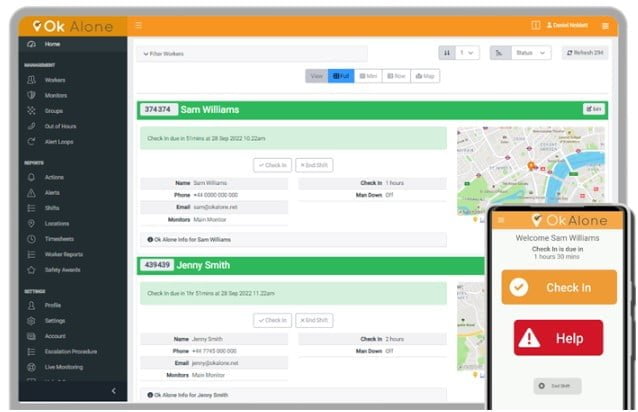As a business owner or manager, you know that efficient workflows are crucial to your success. But what happens when your team includes lone workers, such as those who work remotely, on-call, or in hazardous environments? Without the right tools, managing these workers can be a challenge. That’s where a lone worker app comes in. By integrating a lone worker app into your workflow, you can improve communication, safety, and productivity.

What is a Lone Worker App?
A lone worker app is a software application designed to support the safety and productivity of employees who work alone or in remote locations. The app typically runs on a smartphone or other mobile device and provides various features that can help workers stay connected, safe, and productive. Some common features of a lone worker app include:
- GPS location tracking
- Panic button or help alert
- Check-in or countdown timer
- Man/Worker Down
- High-risk setting
- Risk assessment and hazard reporting
- Communication with a monitoring centre or manager
- Emergency escalation procedure
How Can a Lone Worker App Improve Workflow?
Integrating a lone worker app into your workflow can provide several benefits, such as:
Increased safety: A lone worker app can help mitigate risks and reduce response times to emergencies. For example, if a worker triggers a panic button or fails to check-in, the app can alert their monitor to initiate an escalation procedure.
Improved communication: With a lone worker app, workers can stay in touch with managers by regularly checking in even when they are out of the office or working remotely. This can help avoid false alerts or misunderstandings of where people are.
Enhanced productivity: By streamlining communication and safety protocols, a lone worker app can free up time and resources for more productive work. For example, automating check ins means no one is manually trying to track down workers locations and see if they are safe.

Tips for Integrating a Lone Worker App into Your Workflow
Conduct a Risk Assessment:
Before choosing a lone worker app, it’s essential to assess the risks and hazards associated with all your workers’ activities in different roles and locations. This can help you identify the features and capabilities you need in an app and ensure that it aligns with your safety policies and regulations. Some factors to consider when conducting a risk assessment include:
- Type of work and location
- Environmental hazards
- Communication needs
- Worker experience and training
- Emergency response procedures
Choose the Right App:
Once you have conducted a risk assessment, you can start evaluating the available lone worker apps to find the one that best meets your needs. Some factors to consider when choosing a lone worker app include:
- Features and capabilities
- User-friendliness
- Compatibility with existing technology
- Support and training options

Implementing a Lone Worker App in Your Workflow
Introducing a lone worker app to your organization can improve safety and productivity, but it’s important to follow a structured approach to ensure its successful implementation. Here are some steps to consider:
Employee training and communication: Provide comprehensive training to employees on how to use the app, including its features and benefits. Communicate the importance of the app in improving safety.
Integration: To ensure seamless integration with your existing workflow, identify the tasks and processes where the app can be most effective. Then, adjust the existing workflows accordingly.
Evaluate the effectiveness of the app: Regularly evaluate the app’s effectiveness and gather feedback from employees.

How Can I Ensure Workers Will Use the App?
Introducing a lone worker app to your organization is only effective if employees actually use it. To ensure workers will use the app, it’s important to involve them in the decision-making process, provide adequate training, and emphasize the benefits of using the app. Additionally, you can make the app a requirement for certain tasks and processes, such as safety checks and risk assessments.
Develop a strategy to encourage employees to use the app regularly. For example, you can incentivize usage, create a competition or gamification system such as employee Safety Awards, or include the app usage as part of performance metrics.
Providing ongoing support and feedback can also help encourage employee adoption and engagement with the app. Ensuring management are using the app shows employees they are not being punished or ‘tracked’ by the company.
By taking these steps, you can increase the likelihood that workers will use the app and help improve safety and productivity in your organization.
Conclusion
In conclusion, integrating a lone worker app into your workflow can bring numerous benefits to your organization, including increased safety and productivity. By providing real-time location tracking, frequent check ins and automated alarms, lone worker apps can help ensure the safety of employees who work alone or remotely. Additionally, they can streamline workflows, leading to increased productivity and efficiency.
Businesses should consider implementing a lone worker app to improve safety and productivity in their organization as well as demonstrating their commitment to employee safety and well-being. With the right training and adoption strategies, businesses can ensure that their employees regularly use the app to its full potential.

As an expert in lone worker content management, I possess an extensive knowledge base and experience in the area of lone working and safety monitoring. My expertise in this field encompasses a wide range of areas, including risk assessment, training, communication, and technology. I have a deep understanding of the unique risks associated with lone workers and have researched and written many projects and articles to educate people in how to mitigate these risks.
Throughout my time with Ok Alone, I have kept up to date with technological developments, legislative changes and regulations that have been introduced to help organizations ensure the safety of their lone workers.
